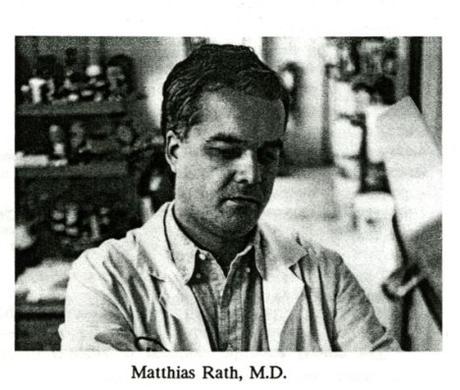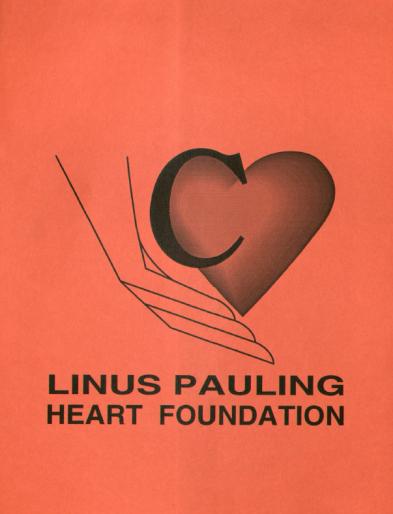
[An examination of Pauling’s research on vitamin C and heart disease. Part 2 of 4.]
In 1989, a young medical doctor by the name of Matthias Rath began working at the Linus Pauling Institute of Science and Medicine. Rath had come from Germany, where he and his colleagues had uncovered evidence that the cause of plaque development in atherosclerosis (the hardening of arteries brought about by cholesterol deposits) was not a direct result of the presence of Low Density Lipoprotein (LDL), as had been previously thought. Rather, the Rath group found that LDL was synthesized in the liver into a new substance called lipoprotein (a), which binds to and carries cholesterol to sites throughout the bloodstream, building up on arterial walls in the process.
In moving to the Pauling Institute, Rath brought with him a specific interest in the potential relationship between vitamin C and lipoprotein(a), or Lp(a). He hoped that, in collaborating with Linus Pauling, he might be able to more fully explain the preventative effects of vitamin C on cardiovascular disease that had been observed in vitamin C-deficient animal models.
However, within the field, there existed significant skepticism as to whether vitamin C could actually affect Lp (a) levels in the blood, since these levels were not known to be modifiable by diet or drugs; – rather, the operating assumption was that the levels were genetically determined. Furthermore, concerns were raised that high doses of vitamin C might lead to an increased zinc-to-copper ratio in the blood, the end result being hypercholesterolemia and a concurrent increase in the risk of stroke or heart attack.
Skeptics also argued that an intense regimen of vitamin supplementation might spur the development of kidney stones, due to the acidification of urine in patients unable to take sodium ascorbate for health reasons. Additional fears were expressed that large doses of vitamin C, vitamin E, and other nutrients that act as blood thinners might interact dangerously with blood-thinning medications taken by many heart patients already.
Unsurprisingly, Rath and Pauling were hopeful that a solution could be found that would put to rest all of the naysaying. In this, the duo was driven by a belief that an optimum amount of vitamin C and other vitamins would mitigate any negative complications while simultaneously preventing a majority of heart disease.
By February 1990, Rath and Pauling were preparing to run experiments using vitamin C-deficient guinea pigs with induced atherosclerosis. These trials, according to Pauling, were devised by Rath and based on the idea that lipoprotein (a) synthesis in a small number of animals might be correlate with the inability to synthesize vitamin C. Pauling remained involved mostly as an eager and interested advisor and patron for Rath’s work on the subject.
In terms of their business arrangement, Pauling made it clear early on that Rath should not be held to the regular patent agreement for LPISM employees (25% royalties to the inventor, 75% to the Institute). Since Rath had developed the idea and foundational work outside LPISM, Pauling suggested a 50/50 split on the profits.
In addition to his scientific work, Rath was also a peace activist, an outspoken opponent of international corporate exploitation, and an advocate for the control of nuclear weapons, and as such he had followed Pauling’s political exploits with great personal interest for many years. Perhaps because of these shared qualities and the growing connection between the two, Rath refused the favorable 50/50 deal that Pauling had recommended. Instead, Rath communicated to Pauling that he believed the Institute should receive any and all profits, leaving Pauling to infer that Rath required no royalties for what he viewed, in principle, as an effort to decrease the amount of suffering endured by people with heart disease. In the end, Rath never signed the Institute’s patent agreement at all.
The first major paper to emerge out of Rath and Pauling’s collaboration was published in Proceedings of the National Academy of Science in December 1990 and titled “Immunological Evidence for the Accumulation of Lipoprotein(a) in the Atherosclerotic Lesion of the Hypoascorbemic Guinea Pig.” The publication reported on Rath’s study and showed that vitamin C protected arteries from fatty build-up at an intake of what would be about 5 grams a day in humans, as adjusted for weight. This dose stood in stark contrast to the much smaller Recommended Daily Allowance at that time, which was 50 mg.
With this paper, it appeared that Pauling had finally acquired a critical piece of evidence that he had been searching for ever since writing Vitamin C and the Common Cold in 1970: experimental proof that a widespread lack of vitamin C in the human diet was resulting in negative health consequences that ranged far beyond scurvy. Likewise, for Pauling, the Rath studies were a clear indication that the federally recommended dose, though sufficient to prevent scurvy, was by no means optimal. Rather, at 50 mg per day, humans were living in a state of chronic vitamin C deprivation and were suffering from a wide range of maladies as a result.

From 1990 on, the connection between vitamin C and heart disease took center stage in Pauling’s life. Invigorated, he and Rath both saw the topic as a key new focus for research at the Institute, and a program that would pair well with growing national interest in orthomolecular medicine and in controlling health through diet.
To promote this vision, The Linus Pauling Heart Foundation was established as a non-profit agency that aimed specifically to raise money to support the clinical trials needed to determine the exact value of different doses of vitamins needed to prevent cardiovascular disease. In addition to the vitamin C work, the Foundation also sought to generate funds that would support investigations into alternative heart therapies that used proline, lysine, and niacin.
Once it was established, Pauling named Rath as president of the Foundation, which operated separately from the Institute, but with some financial backing. To draw support for the Foundation’s work, Pauling made regular appearances on media outlets in the San Francisco Bay Area. Likewise, over the course of the next two years, he issued a steady stream of press releases arguing in favor of the use of vitamin C, vitamin B3, nicotinic acid, and lysine to prevent and even reverse the onset of cardiovascular disease. In these, Pauling also alluded to the notion that Lp(a) might be implicated not only in heart disease, but also in diabetes and cancer. No specific optimal vitamin intake was ever detailed in the news releases. Instead, readers were encouraged to make donations to the Foundation so that research to better understand the role that vitamins play in controlling heart disease might more rapidly progress.
